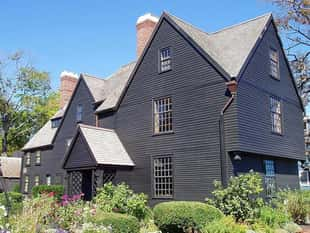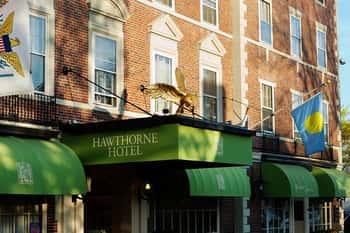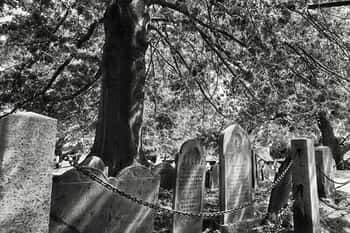Gloomy, dark, and witchy are some of the words that come to mind when describing historical architecture in Salem, Massachusetts. The Pickman House is no exception. Only a few feet away from the Peabody Essex Museum, the house stands in all its creepy, Colonial glory.
Its gray wooden exterior combined with opaque diamond-paned windows emit an eerie, spine-chilling feel. The five-window casements surround a large faded scarlet door, with a handle so antiqued, one would imagine it had been installed during the home’s inception. The steep, slightly moldy roof and central brick chimney preserve the distinctive charm of the past within modern-day Salem.
The house, located on 43 Charter Street, was built by Samuel Pickman in 1665. Pickman was a sailor, much like the majority of Salem Town’s population at the time.
Once the Colony had been established, the town’s thriving port attracted wealthy merchants and mariners to its shores. It is no surprise that many of the early constructions in the area belonged to people in this line of work.
The land in which the dwelling stands was bought by Pickman in 1657. He is thought to be the original owner of the home since his estate inventory mentions a house in this spot.
In 1964, the house was purchased by Historic Salem, Inc. with the intent to preserve its history and unique architectural style. The company began the restoration but was unable to finish it. A few years later, in 1969, the property was sold to Philip A. Budrose who completed the full restoration.
In the late 1970s, tours were conducted showcasing the inside of the property. According to Debbie Murray, a former Pickman House tour guide, each one of the rooms had a button-activated mannequin, along with 17th-century paraphernalia.
Each mannequin represented a historical figure, depicting scenes and narrating stories that pertained to the house. During this time, the red barn beside the house operated as a gift shop.
While tours were being conducted in the home, the layout consisted of three bedrooms - one on the first floor and two on the second floor -, a kitchen, and an attic that had been converted into the curator’s quarters. There was no mention of a bathroom or living room area.
In 1983, the house was purchased by the Peabody Essex Museum, to conserve the historic significance of the site and has since remained under the same ownership.
The Salem Witch Trial Memorial was built behind the Pickman House in 1992, where markers were placed to commemorate the many executed during the witch craze.
Next to the home is the Old Burying Point Cemetery, the oldest cemetery in Salem. All three constitute part of what is known as the Charter Street Historic District.
Among the many people that once called the Pickman House home was French painter Michele Felice Corné. The artist was famous for his beautiful marine paintings, murals, and portraits.
However, his most important accomplishment was introducing the tomato to the New World. In the early 1800s, when Corné arrived in Salem, he quickly noticed that no one consumed the juicy, red fruit.
At the time, New Englanders thought the fruit was poisonous. Corné, who grew up in Italy, was accustomed to eating tomatoes of different varieties. He decided he would prove they were safe to consume by sitting on his stoop and devouring them.
At first, he struck everyone as odd but soon the misconception was forgotten; forever changing the trajectory of New England cuisine.
Another significant resident was Salem-born Judge and Chief of Justice, Benjamin Lynde Jr. Although it has been confirmed that Lynde lived in the house, the exact time frame is unknown. Lynde is famous for his involvement in the 1770 Boston Massacre Trial, after an argument between a British soldier and a wigmaker turned into a disarrayed bloodbath.
With a reputation for being one of the oldest buildings in Salem, it’s no wonder the Pickman House is thought to be incredibly haunted. For centuries, people have entered and lived in this home, bringing with them powerful energies that linger within its walls.
As with many ghost stories, the origins of the Pickman House hauntings have been attributed to gruesome deaths that occurred there. These legends have been passed down orally from generation to generation, as part of local folklore. Among these hair-raising tales is the story of a sinister murder-suicide said to have taken place in the 18th century.
According to local legend, a family of three had moved into the home; a man, his wife, and his seven-year-old daughter. Shortly after settling in, the man’s mental health began to deteriorate, declining each day until he reached the point of insanity.
He claimed he could see and hear demons in the home. In his struggle to fight the evil entities that plagued his existence, he became increasingly irritable. His violent outbursts would horrify his family. Each one more jarring than the one before.
One day, amid one of his maniacal episodes, he chained his daughter in the attic, deprived of all the comforts she once enjoyed. She defecated and urinated in place; starving, alone, and frightened. With each passing day, she waited for death to release her from the pestilent confinement.
His wife was petrified. Torn between wanting to protect her daughter and being too scared to face her husband, knowing what he was capable of. Putting her fears aside, she begged her husband to release their child but her pleas did not affect the already shattered man.
Eventually, the man got tired of his wife. Irritated by her presence, he gathered rope and tied her to a tree in his yard. He made his way to the kitchen, where he began to heat a large block of wax.
After the wax had come to a rolling boil, he grabbed his rusty cast iron pot and poured it over his restrained wife’s head. Her end did not come quickly. She screamed and howled in pain for what would seem like an eternity. Dying a slow, agonizing death.
Once his wife’s blood-curdling screams had been drowned by the hardened wax, he went back inside the house and hanged himself.
Although there were three simultaneous violent deaths in the house, the spirit of the famished girl is the one seen most often. While snapping photos of the building, visitors have captured what looks to be a young girl staring out the second-floor window.
Employees of the museum across the street claim to have heard disembodied voices at night, particularly voices that sound like children. Aside from the strange sightings of the girl, pictures have captured bright orbs and human faces floating inside the house.
With humanity’s incessant need to optimize its surroundings, many historic buildings have been renovated to accommodate modern needs and taste. This is why Pickman House is so special. Restored to its original style, the building is a time capsule, a still image from the past.
Although the home is currently closed to the public, it is still visited by locals and tourists that enjoy strolling along its sidewalks and peeking through its windows. Visit Pickman House to indulge in a First Period Colonial experience with a spooky atmosphere!

One of Salem's most famous haunted houses

Spend a night in Salem's most haunted hotel

One of Salem's haunted Cemeteries